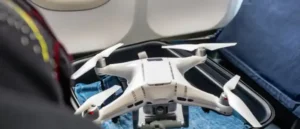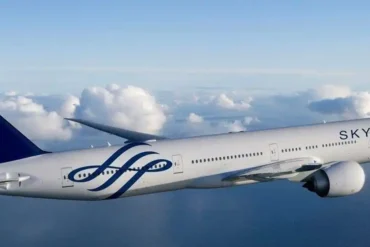Ever wondered if it’s okay to bring your drone on a plane? Well, good news! In the U.S., flying with drones is generally allowed, and passing through TSA checkpoints is a breeze. Still, there are some nitty-gritty details to consider, especially when it comes to battery storage and arrival procedures. Let’s break down everything you need to know about taking your drone on a flight:
Navigating TSA with Your Drone
When flying within the U.S., you’re in the clear to bring your drone through airport security. The Transportation Security Administration (TSA) explicitly gives the thumbs up for drones at checkpoints, allowing you to stash it in your carry-on bag.
Now, the question arises: Should you take the drone out of its bag during security checks? TSA guidelines are a bit fuzzy on this. They mention that unless you have TSA PreCheck, large electronic items like laptops need to be removed. But what defines “large” is left to interpretation.
To play it safe, I usually take the proactive step of removing the drone or inform the TSA agent about the drone in my bag, seeking their preference regarding removal.
Choosing Between Carry-On and Checked Luggage for Your Drone
Does it matter whether your drone is in your carry-on or checked luggage? For larger drones, checking might be your only option. Thankfully, with today’s compact drones, carrying them in your carry-on is usually the way to go. It’s my preferred method to reduce the risk of losing or having my drone pilfered during our time apart.
While airlines may have their own rules (we’ll get to that later), the decision between carry-on and checked luggage often boils down to personal preference.
However, the packing of drone batteries has specific rules:
What About Traveling with Drone Batteries?
TSA doesn’t restrict drones per se, but it does have specific guidelines for lithium-ion drone batteries, shaping how you can travel with a drone.
All spare or uninstalled lithium-ion and lithium-metal batteries, including drone batteries, are only allowed in carry-on baggage, as stated by the Federal Aviation Administration. Checked baggage is a no-go for lithium-ion drone batteries.
Limits on Watt Hours (Wh)
Moreover, there are occasional restrictions on the power capacity of your drone battery. Lithium-ion rechargeable batteries, common for drones, are capped at a rating of 100 watt hours (Wh) per battery. Exceed that, and you’ll need airline approval. If you have drone batteries ranging from 101 to 160 Wh, the TSA allows a maximum of two such batteries.
You can usually find the Wh information in your drone’s user manual. Most consumer drones fall within the air travel limit. However, enterprise and high-powered drones might surpass this limit. For example, DJI’s TB65 Intelligent Flight Battery, found in drones like the DJI Matrice 350 RTK, boasts a 263 Wh capacity, making it ineligible for carry-on according to airline regulations.
Handy Drone Packing Tips
Here are some concise tips for packing your drone:
- Remove your drone battery from the drone: Avoid accidental bumps to the power button mid-flight, preventing the drone from turning on and draining the battery.
- Secure packing: Don’t get lazy with cases and covers. Always ensure the gimbal is securely in place, especially considering the rough handling of luggage.
- Discharge your battery: While not mandatory to deplete the battery completely, it’s generally advisable to discharge your drone’s battery to 50% or less.
- Fire-safe battery bags: Add an extra layer of caution by using fire-safe bags. Despite their bulk, fireproof battery pouches can fit into an existing carry-on bag. If you’re carrying multiple batteries, fireproof Lipo battery storage bags may count as your carry-on.
- Know the rules: Get familiar with the rules, and be aware that TSA agents or airline staff may not be well-versed in every battery limit detail. Jonathan Atkin, creator of Aerial Maritime Photography Shipshooter Productions, suggests carrying a laminated sheet with TSA requirements for LiPo batteries in your drone case, ready to show if needed.
Especially when placing a drone in a suitcase, use the gimbal cover to shield your camera and gimbal.
Airline Rules vs. TSA Rules for Bringing a Drone on a Plane
While the TSA oversees airport regulations, airlines have the power to establish their own guidelines on items allowed on planes. Just like they decide on more everyday items like pets, airlines determine the permissibility of drones.
Most U.S. airlines generally allow drones but often have specific rules on packing and battery regulations. Typically, these align with TSA regulations, stating that batteries must stay in the main cabin, while the drone body’s placement is less restricted.
For example, Delta Airlines requires removing lithium-ion batteries if surrendering your drone at the boarding gate or check-in for cargo loading.
Southwest Airlines, in line with TSA guidelines, specifies that spare batteries must be in your carry-on or with you onboard.
Always check with your airline for clarity. Additionally, understand both your airline’s and the TSA’s luggage size restrictions to ensure your carry-on with the drone complies.
Traveling with a Drone: Rules Upon Arrival
Within the U.S., flying drones is generally a breeze. While some limitations exist around flying drones in National Parks or near airports, drone usage is legal. The FAA’s B4UFLY website or mobile application can guide you on legal drone flying locations in the U.S.
However, international drone travel introduces a different dynamic. Some countries outright ban drones, allowing you to board a U.S. flight with a drone, but the destination country’s Customs and Border Patrol might confiscate it. Successfully boarding with a drone does not guarantee the same privilege on foreign soil.
Certain countries like Iran, Syria, Egypt, Ethiopia, and others categorically prohibit drones without a special government exemption. Antarctica also imposes a drone ban.
Other countries may not ban drones but have specific rules for registration, certification, or licensing, along with requirements for drone insurance and flight restrictions. Check your country’s drone laws before flying.
Regardless of your location, practice respect for fellow vacationers, private property, wildlife, and locals when flying drones. It’s essential to be aware of and follow the rules to ensure a positive experience for both yourself and those around you.
Conclusion
While the idea of bringing your drone on a plane might seem daunting, it’s generally manageable with the right knowledge and preparation. Understanding TSA and airline guidelines, along with the rules of your destination, can help you navigate the skies with your drone hassle-free. So, pack your drone, follow the rules, and get ready for some breathtaking aerial views on your next adventure!


















